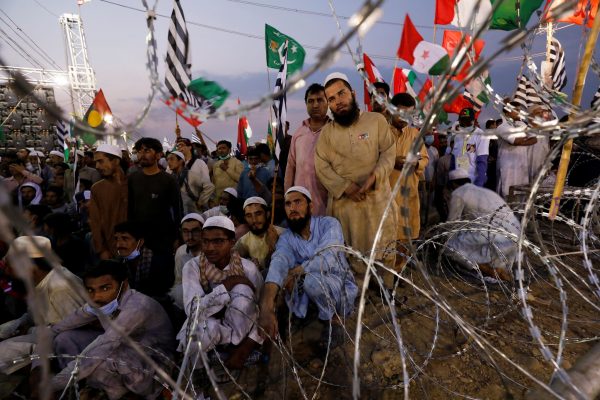Pakistan’s success in initially containing COVID-19 this year was a good omen. It revealed a nation collectively resolved to deal with the latest crisis. When cases began rising in April, the response was effective, despite some criticism. Prime Minister Imran Khan’s government worked in concert with the military, coordinating provincial lockdowns and establishing a National Command Operation Centre (NCOC) to oversee a national response. Piggybacking on Pakistan’s polio-related health capability and co-opting religious and other civil society groups to communicate messages about isolation, social distancing and safe practice, the government contained the spread, achieved a relatively low death rate, and looked set to limit the economic fallout from the pandemic.
Compared with neighbouring India, the United States and much of Europe, Pakistan had done well.
But COVID-19 cases are on the rise again and, as is common practice in Pakistan, the military is stepping in to fill a leadership void and shows no sign of retreating. The NCOC is stacked with military figures, and recently-retired military officers have growing influence in Khan’s administration.
In Pakistan, it’s commonly said, civilian governments serve at the army’s pleasure. Civilian governments are elected and survive with the tacit support of the top brass. Fail to keep the military happy and disgruntled generals retake the reins. Pakistani army journals are full of senior officers lamenting the state of civilian politics and national institutions, undermining their authority and effectiveness.
One big problem in Pakistan has been the tribal areas — formerly the Federally Administered Tribal Areas (FATA) — that have long been a source of social and political instability. FATA no longer exists as a political unit, having been absorbed into neighbouring Khyber-Pakhtunkhwa province in 2018 in an attempt to address deep-seated economic and security issues. Despite the merger’s admirable intention of normalising the situation in an area previously governed under archaic colonial-era laws, little has happened to change the fundamental problem except the redrawing of the map. Pakistan’s institutions are too weak to deliver change or implement the administrative, judicial, security and economic reforms necessary for change to occur.
Another big problem is the overstretched energy grid that fails frequently and doesn’t even reach an estimated 40 million of the country’s population. This problem also has a solution — abundant renewable energy potential including wind, solar and hydropower. The Alternative and Renewable Energy Policy 2019 is an ambitious plan to harness new resources and boost economic performance. But the governance failures responsible for past energy problems bedevil delivery of a new energy future.
There are bright spots. China’s US$62 billion investment in the China–Pakistan Economic Corridor (CPEC), though it comes with some inherent dangers, is a major opportunity to reboot Pakistan’s development. CPEC’s massive infrastructure and energy projects have the much-needed potential to modernise Pakistan’s economy. There are opportunities for foreign investment. The trappings of democracy provide some assurance to investors despite regulatory dysfunction. And there is the asset of a young, politically-literate and sizeable population.
Yet the prospects for Pakistan and particularly for its economy are not good, as Ilhan Niaz points out in our lead article this week and the first in EAF’s annual Year in Review series. Skyrocketing food prices and energy sector debt, coupled with a low tax take, had set Pakistan up for a poor year even before the impact of COVID-19. The economy is in no state to achieve the 7 per cent growth necessary to keep pace with its rapidly growing population, according to Niaz.
Pakistan’s poor economic form appears entrenched. The economic and political struggles in 2019 — austerity, inflation, rising public sector debt, and economic growth of just a few per cent — have not been seen off yet. Settling on the best way forward seems a reach too far — politicians, generals, clerics, separatists, militants and activists of all shapes and sizes are pulling the country in different directions.
There has been some progress, however. Most impressive has been success in bringing domestic terrorism and violence under better control. Pakistan’s role in encouraging the Taliban to the negotiating table in Afghanistan is another important achievement. Though little progress has been made in convincing Baloch separatists to accept central government rule. Behind most of the success, unfortunately, the military and not the civilian government seems to be the driving force. The impression that only the military gets results is not a narrative helpful to entrenching democracy.
Will 2021 tell a different story? The country has recently been wracked by large protests whipped up by the opposition PML-N. While this is par for the course in Pakistani politics, what is less usual is the open criticism of the army and its chief General Bajwa in traditionally pro-military Punjab. Whatever the outcome, one can only continue to hope for steps that build the foundations of democracy and stability.
The EAF Editorial Board is located in the Crawford School of Public Policy, College of Asia and the Pacific, The Australian National University.


Pakistan’s basic problem is religious intolerance. An in-depth analysis of the initiation of various martial laws in the country shows the religious leaders of various factions have used this problem to create disturbances resulting in the army’s role. Sometimes the generals wanted it and at other times the politicians’ inability to control the country. As long as the religious leaders remained under control the country progressed reasonably well. Now the religious card played by various factions is out of control. No progress may be expected in this environment.